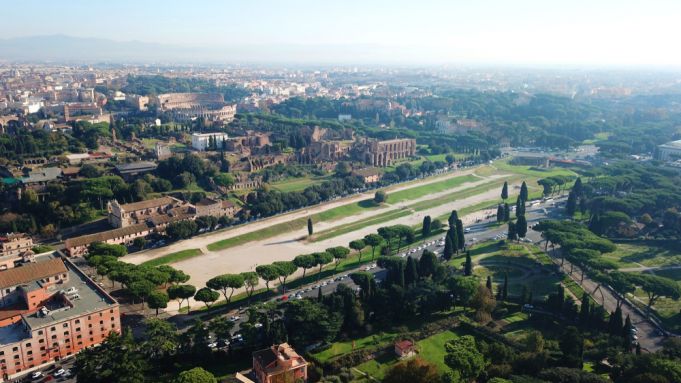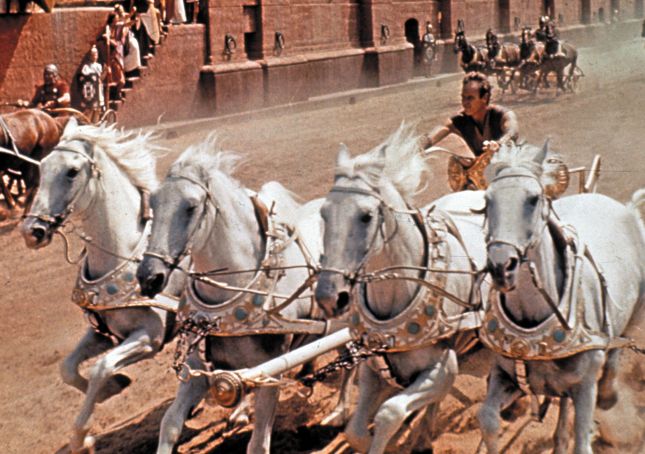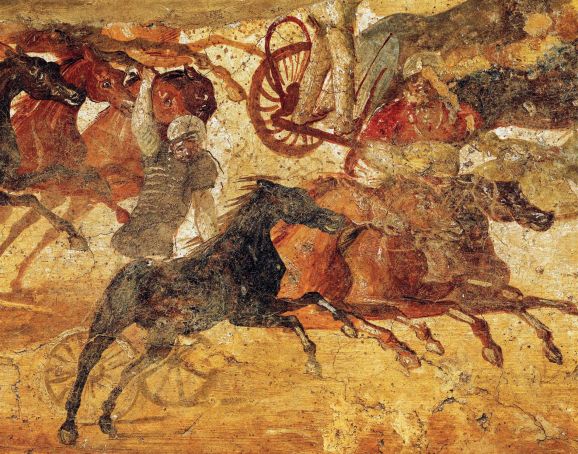Exploring the history of Rome's Circus Maximus by taking reverse laps back to its beginnings.
By Martin Bennett
Early morning. But for a man slowly walking his dachshund, the vast oval of grass and tawny-coloured gravel lies empty.
Now accelerate backward to 2016. In a flurry of spotlights there’s David Gilmour, then Bruce Springsteen and the E-Street Band. Reverse two summers earlier, Mick Jagger appears and disappears in a jumping jack flash. Another decade and in pompa triumphalis AS Roma's Francesco Totti lifts high lo Scudetto in football triumph.
Picture next orti di guerra, summer-camps for Mussolini’s youth movement, exhibitions and sporting displays prematurely celebrating long-lost grandeur while archaeologists come and go, excavating the area, covering it up again so it can resume an agricultural function.
St Francis of Assisi
Landmarking the 19th century, to grind grain for the Roman populace there is a mill powered by the Marrana water-course running underground.
That tower, for its part, is mediaeval, an add-on by Rome's powerful Frangipani family who recycled Circus masonry for defensive purposes. 1229 might afford a glimpse of Saint Francis, sometime guest of one Iacopa, a Frangipani widow.
Gripping the reins or, like an ancient charioteer, wrapping them round your waist, fast-backward an entire millennia.
Eight metres below where strolls that one man and his dog today, the site, five-soccer-pitches-long, would have been thronged, 66 days per annum, with up to 385,000 spectators (an estimate from Constantine’s reign).
Not to mention sub-populations of bookies and bakers, butchers and bar-keepers. Even launderers, using ammonia from the ready urine-supply from between-race drunkards to aid the fulling process.

All these trades capitalised on a venue which on race-days became Rome’s busiest shopping centre. Nor were the sexes separated, unlike in other public venues. Ovid’s Ars amatoria recommends the cavea and archways as an ideal spot for dating.
More sourly Juvenal mentions "the whores pimped out around the racecourse./ That’s where you go if you fancy a foreign pick up" – Peter Green’s translation. Or in the same vein, "Women and low rank and fortune learn their future/ down at the racetrack", astrologers touting another attraction.
Panem et circenses
Reaching 50 km per hour, first and foremost came the charioteers, negotiating seven laps of a track. Or five laps, as later emperors wise to the motto panem e circenses met demand by cramming more races into a single day.
"A people that yawns is ripe for revolt," to cite Caracopino, venerable author of Daily Life in ancient Rome. "Spectacles were the great anondyne against unemployment, the Caesars' sure instrument of their absolutism."
I recall attending, as a tender eight-year-old, a Kingstanding Odeon matinée of the 1959 film Ben Hur. Excuse then any confusion between the plot’s Jerusalem’s (or Antioch’s) Hippodrome with the site here: again in the memory charioteer’s elongated hub-caps eat away, splintered spoke by spoke, at Charlton Heston’s wheels. How the hero’s leather-and-wooden basket of a vehicle withstands such attrition remains a cinematographic miracle.
Ben Hur
Contrasting with Birmingham’s suburban grey, in glorious technicolour glint the three bronzen cones of the metae – the hairpins at the end of the spina, the central divide with its fountains, shrines and, then Egyptian obelisks under Augustus then Constantius II.
For dramatic appeal, Cinecittà film studio modelled its set for Ben Hur after Rome’s Circus Maximus rather than Middle Eastern equivalents. Indeed the intention had been to use Circo Massimo itself; only the urban authorities refused permission for conservation reasons. The producer had to make do with Circus Maxentius along Via Appia Antica.

Back to the movie's racing scenes. Rival charioteer, failing to ram Ben Hur against the walls, resorts to some equally dastardly whip-work. Unlike Formula 1 racing with its anti-roll-bars and safety-cars, competitor security was minimal, most charioteers being infames or slaves. Victory could buy their way to freedom. Life-expectancy, however, averaged 25 years for charioteers.
Time, then, to substitute Ben Hur with the more historically authentic Flavius Scorpus. Under Domitian, Martial ventriloquises the epitaph: "I am Scorpus, most acclaimed of charioteers./ Or was. Circus fame is not sooner enjoyed than it’s over./ Envious destiny snatched me hence, aged 27 years;/ numbering my victories it reckoned I must be older."
Perils and curses
Other perils existed off track. Performance-enhancing drugs having yet to be invented, a competitive edge could be gained by poisoning. Guilty in this regard were betting syndicates and even emperors: Caligula and the gambling-addict Vitellius. The victim could be the ‘wrong’ team’s driver or its horses.
Galen, the famous classical physician, reports that public interest extended to sniffing equine manure for signs of foul play. Then came curses. Near the racetrack in Caesarea, present-day Israel, leaden scrolls have been found in wells, a conduit to the underworld and the forces living there. "Bind and blind the opposing rider," threatens one.
Compensating such dangers was prize-money. In a less sympathetic epigram Martial complains that he, the poet, joins a line of raggle-taggle togas each dawn for a few lead coins from his tight-fisted patron, whereas Scorpus in one hour’s work carries away 15 sacks of fresh-minted gold.
As Martial’s friend Juvenal observes, "A hundred lawyers/ make only as much as one successful charioteer." One Diocles after a record 1,462 victories is said to have amassed 35 million sesterces; convert that into pounds, he’d have outearned Lewis Hamilton or Valentino Rossi.
Gambling
Spectators, for their part, could win (or lose) smaller amounts from betting. Or between races, by catching one of the wooden balls the emperor tossed form the pulvinar / royal box. Inside each a parchment scrap guaranteed prizes of anything between a pittance and the cost of a country mansion.
As Scorpus and the other riders plus the 48 horses approach the carceres / mechanised starting gates, it’s time for one last backward lap for the reader.

Centuries per second, reverse the imagination to when Rome was a village, the stadium of stadiums between the Aventine and Palatine hills was geological rather than man-made, no seating except the Valle Murcia’s flowery slopes, now home to Rome's rose garden. It is September 750-something BC.
Romulus
Later marked by the western meta / endpost, the one architectural feature is an altar to Consus, god of horses, mules and donkeys. To celebrate harvest the same quadrupeds have a hard-earned day off. Onto the scene steps Romulus. As Livy tells it, Rome’s founder has a demographic crisis on his hands.
His settlement on the Palatine has a serious shortage of women; to ensure its survival Romulus has sent messengers to nearby tribes, requesting their daughters in marriage to satisfy his frustrated subjects. No consent being given, he resorts to a stratagem and invites the neighbouring peoples (especially their females) to the Consualia with the promise of wine and a good time for all.
As in Pietro da Cortona’s painting in the Capitoline Museums a couple of hills away, the Sabine guests look on aghast: Their womenfolk, by force of Roman biceps, are being hauled off to the huts on the Palatine. (Two of Cortona’s life-size figures – Roman male and Sabine virgin – would become models for Bernini’s Daphne and Apollo statue in Galleria Borghese).
A war ensues, only to be ended by the same women, now Romanised wives and matrons. Interposing their bodies between their furious (Sabine) fathers or brothers and their Roman husbands, they beg both sides not to shed kindred blood.
"Silence fell," Livy continues. "Not a man moved. Romulus and the Sabine commander stepped forward to make peace…" The two peoples unite. Two kings later, Marcus Ancius, after defeating the Latins, chooses the same Valle Murcia for his Pompea Triumphalis. Rome is already on the road to empire.
Further interweaving sport, religion and politics, in 329 BC Tarquin Priscus builds the first permanent circus, adding (wooden) carceres and central spina to cover the drainage channel/fore-mentioned Marrana leading into the nearby Tiber.
Seven laps
But to return to around 90 AD, hooves are beating, the crowd is getting restless. Behind his carcere Scorpus sports Imperial green, the other teams white, blue and red, colours in another astrological link signifying the course of the seasons, the seven laps that of the seven then-known planets or days of the week.
The spartatores retire, having sprinkled the dusty track with water to maintain visibility. Drop of the presiding magistrate’s white cloth: the competitors this time surge forward on their seven laps, if they’re lucky, gilded dolphins and septem ova / stone eggs, another ancient lap-marker, counting them on their way. May the best team win.
This article was published in the February 2021 edition of Wanted in Rome magazine.
















